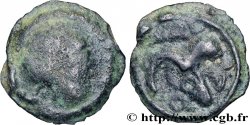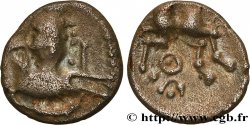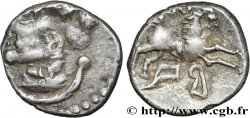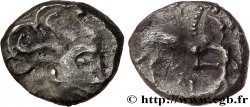bga_412078 - EDUENS, ÆDUI (BIBRACTE, Area of the Mont-Beuvray) Quart de statère en électrum à la lyre, type de Chenôves
Not available.
Item sold on our e-shop (2018)
Price : 600.00 €
Item sold on our e-shop (2018)
Price : 600.00 €
Type : Quart de statère en électrum à la lyre, type de Chenôves
Date: c. 70-50 AC.
Mint name / Town : Autun (71)
Metal : electrum
Diameter : 11,5 mm
Orientation dies : 8 h.
Weight : 1,78 g.
Rarity : R2
Coments on the condition:
Bel exemplaire sur un flan un peu irrégulier mais avec des types complets. Patine régulière, avec de petites zones sombres au revers en bord de flan
Obverse
Obverse legend : ANÉPIGRAPHE.
Obverse description : Tête humaine laurée à droite, la chevelure stylisée ; grènetis.
Reverse
Reverse legend : ANÉPIGRAPHE.
Reverse description : Cheval galopant à droite ; au-dessus du cheval, l'aurige ; lyre sous le cheval.
Commentary
Ces monnaies du type de Chenôves se divisent en deux types ; à la lyre (classe I) ou à la rouelle (classe II). Le traitement de la chevelure correspond exactement à celle du statère DT. 3176 avec les mèches en forme de goutte et aux extrémités enroulées.








 Report a mistake
Report a mistake Print the page
Print the page Share my selection
Share my selection Ask a question
Ask a question Consign / sell
Consign / sell
 Full data
Full data









